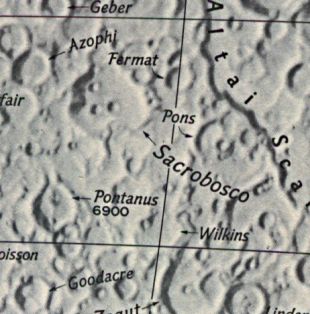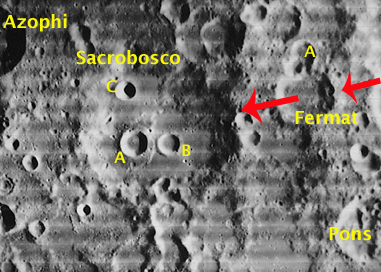

Observer: Tony Donnangelo/Dave Mitsky Date/time of observation: 2004/08/22 00:30 U.T. Site location: Cherry Springs State Park, Potter County, PA, USA Site coordinates: N. 41°39’43.2” (41.66199°) W. 77°49’28.9” (77.82470°) Site elevation: 707 meters (2,319 feet) Site classification: State park (isolated area) Instrument: 14.5” Starmaster Dob. Magnification: 203x & 267x Moon's age: 5d 23:05 Illumination: 34.7% Apparent Dia.: 31.9’ Range: 374,577 Km. Librations: 4.9°, PA 84°, N/S .50° E/W -4.86° Object: Sacrobosco (crater) Dimensions: 100x100 Km. (59x59 Mi.) Height: 3,500 Km. (10,600 Ft.) Height/Wide ratio: 0.0357 Lunar ray coordinates: 17.5°E, 23.0°S. Rükl chart #: 56
It was a year since we made the three hour and fifteen minute drive to this official state designated dark sky park set aside and maintained primarily for astronomy. The weather finally cooperated for two days to warrant the trip. It was a minor miracle for this year in Pennsylvania. Since the forecast changed abruptly, we only packed the essentials and made a late departure.
We were prepared for observing at 00:30 U.T., seven minutes into Nautical twilight. The moon was already getting low to the tree line at -16° 31’ declination. The moon appeared unsteady due to atmospheric conditions and mirror cool down. It was one of the clearest nights of the year. The Milky Way blazed forth with many deep sky objects being seen with unaided eye. The only downfall was moisture in the air. Dew began forming at sunset, and everything was soon soaking wet. It was daunting keeping lenses and eyepieces clear. Much of the field was soggy from earlier rains.
An evident shaft of light stretching the length of Sacrobosco’s floor was already in progress. It was slightly cone-shaped and possibly visible at an earlier time. The western interior wall was fully illuminated and appeared highly inclined. The remainder of the floor was shadowed.
Fermat, a crater to the east of Sacrobosco, also contained a pie-shaped wedge of light that illuminated half the crater’s floor. The crater was out of the terminator, and the remainder of the crater and surrounding area was sunlit. It would be interesting to observe both craters at an earlier hour to see if either or both beams of light would be narrower. Both rays would be in line, indicated by the red arrows in the accompanying photo. Tandem rays are an occurrence we are unaware of ever being reported, and a worthy observation indeed.
The ray in Sacrobosco widened rapidly, revealing two of its interior craters. Our observations of this ray were limited because of time spent observing the predicted ray occurring in Meton and accommodating several observers who were interested in viewing these phenomena.
We were mindful of a ray predicted to be currently occurring in Gemma Frisius. We aren’t certain whether it ever occurred; the sun hadn’t yet risen high enough, during our observations of the moon, to create this ray. It may have occurred at a later than predicted time with the moon closer to the horizon. We now turned our attention to this year’s all too unfamiliar endeavor of observing deep-sky objects.
The Initial Predictions, Using Data in Original Reporting
Site Longitude = +76.778
Site Latitude = +40.513
Site Elevation = +524.000
Reproducing Lighting For: 2004/8/22 at 00:30 U.T.
Desired Solar Altitude = +2.681(Rising), Azimuth = +87.289
Feature = sacrobosco
Feature Longitude: = +16.700
Feature Latitude: = -23.700
Average Co-longitude = 346.228
Moon's Altitude Restricted = N
In the Time column, D=Daylight, T=Twilight
---- Moon's ---- -- Earth's --
Topocentric Topocentric -------- Sun's --------
UT Date Time Alt° Semi-Diam'' Long° Lat° Colong° Lat° Azim°
2004/08/22 00:30T +21.110 964.09 -5.051 +1.640 346.845 +1.401 +87.289
Crater Description:
Description from Virtual Moon Atlas: Wrecked and isolated circular formation. Pretty steep slopes supporting many craters with Sacrobosco G & F to the north, Sacrobosco L to the southwest, and the double crater Sacrobosco H to the east. Damaged and high walls ridden by Sacrobosco R to the north and presenting debris to the northeast. Immense and tormented floor supporting three important craters: Sacrobosco A & B to the center and Sacrobosco C to the north. Hills craterlets and depressions.

